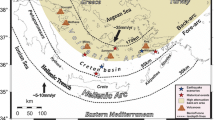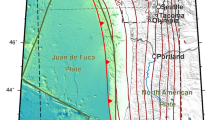Abstract
CyberShake, as part of the Southern California Earthquake Center’s (SCEC) Community Modeling Environment, is developing a methodology that explicitly incorporates deterministic source and wave propagation effects within seismic hazard calculations through the use of physics-based 3D ground motion simulations. To calculate a waveform-based seismic hazard estimate for a site of interest, we begin with Uniform California Earthquake Rupture Forecast, Version 2.0 (UCERF2.0) and identify all ruptures within 200 km of the site of interest. We convert the UCERF2.0 rupture definition into multiple rupture variations with differing hypocenter locations and slip distributions, resulting in about 415,000 rupture variations per site. Strain Green Tensors are calculated for the site of interest using the SCEC Community Velocity Model, Version 4 (CVM4), and then, using reciprocity, we calculate synthetic seismograms for each rupture variation. Peak intensity measures are then extracted from these synthetics and combined with the original rupture probabilities to produce probabilistic seismic hazard curves for the site. Being explicitly site-based, CyberShake directly samples the ground motion variability at that site over many earthquake cycles (i.e., rupture scenarios) and alleviates the need for the ergodic assumption that is implicitly included in traditional empirically based calculations. Thus far, we have simulated ruptures at over 200 sites in the Los Angeles region for ground shaking periods of 2 s and longer, providing the basis for the first generation CyberShake hazard maps. Our results indicate that the combination of rupture directivity and basin response effects can lead to an increase in the hazard level for some sites, relative to that given by a conventional Ground Motion Prediction Equation (GMPE). Additionally, and perhaps more importantly, we find that the physics-based hazard results are much more sensitive to the assumed magnitude-area relations and magnitude uncertainty estimates used in the definition of the ruptures than is found in the traditional GMPE approach. This reinforces the need for continued development of a better understanding of earthquake source characterization and the constitutive relations that govern the earthquake rupture process.









Similar content being viewed by others
References
Aagaard, B. T., Graves, R. W., Ma, S., Larsen, S. C., Rodgers, A., Petersson, N. A., Jachens, R. C., Brocher, T. M., Simpson, R. W., Dreger, D. (2010), Ground motion modeling of Hayward fault scenario earthquakes II: Simulation of long-period and broadband ground motions, submitted to Bull Seismol Soc Am
Abrahamson, N. A., Silva, W. J. (2008), Summary of the Abrahamson and Silva NGA ground motion relations. Earthq Spectra 24(S1), 67–97
Atkinson, G. (2006), Single station sigma. Bull Seismol Soc Am 96, 446–455
Anderson, J. G., Brune, J. N. (1999), Probabilistic seismic hazard analysis without the ergodic assumption. Seismol Res Lett 70, 19–28
Bielak, J., Graves, R., Olsen, K., Taborda, R., Ramirez-Guzman, L., Day, S., Ely, G., Roten, D., Jordan, T., Maechling, P., Urbanic, J., Cui, Y., Juve, G. (2010), The ShakeOut earthquake scenario: Verification of three simulation sets. Geophys J Int 180, 375–404
Boore, D. M., Atkinson, G. M. (2008), Ground motion prediction equations for the average horizontal component of PGA, PGV, and 5%-damped PSA at spectral periods between 0.01 and 10.0 s. Earthq Spectra 24(S1), 99–138
Callaghan, S. E., Deelman, D., Gunter, G., Juve, P., Maechling, C., Brooks, K., Vahi, K., Milner, R., Graves, E., Field, D., Okaya, K., Jordan, T. (2010), Scaling up workflow-based applications. J Comput Syst Sci, special issue on scientific workflows (in press)
Campbell, K. W., Bozorgnia, Y. (2008), NGA ground motion model for the geometric mean horizontal component of PGA, PGV, PGD, and 5%-damped linear elastic response spectra for periods ranging from 0.01 to 10 s. Earthq Spectra 24(S1), 139–172
Chen, P., Jordan, T. H., Zhao, L. (2007), Full three-dimensional waveform tomography: a comparison between the scattering-integral and adjoint-wavefield methods. Geophys J Int 170, 175–181. doi:10.1111/j.1365-246x.2007.03429.x
Chiou, B. S. -J., Youngs, R. R. (2008), Chiou and Youngs PEER-NGA empirical ground motion model for the average horizontal component of peak acceleration and pseudo-spectral acceleration for spectral periods of 0.01 to 10 seconds. Earthq Spectra 24(S1), 173–216
Cornell, C. (1968), Engineering seismic risk analysis. Bull Seismol Soc Am 58, 1583–1606
Day, S. M., Graves, R. W., Bielak, J., Dreger, D., Larsen, S., Olsen, K. B., Pitarka, A., Ramirez-Guzman, L. (2008), Model for basin effects on long-period response spectra in southern California. Earthq Spectra 24, 257–277
Deelman, E., Callaghan, S., Field, E., Francoeur, H., Graves, R., Gupta, N., Gupta, V., Jordan, T. H., Kesselman, C., Maechling, P., Mehringer, J., Mehta, G., Okaya, D., Vahi, K., Zhao, L. I. (2006), Managing large-scale workflow execution from resource provisioning to provenance tracking: The cybershake example, 2nd. International conference on e-science and grid computing, Amsterdam.
Field, E. H. (2000), A modified ground-motion attenuation relationship for Southern California that accounts for detailed site classification and a basin-depth effect. Bull Seismol Soc Am 90, S209–S221
Field, E. H., Jordan, T. H., Cornell, C. A. (2003). OpenSHA: A developing community-modeling environment for seismic hazard analysis. Seismol Res Lett 74, 406–419
Field, E. H., Dawson, T. E., Felzer, K. R., Frankel, A. D., Gupta, V., Jordan, T. H., Parsons, T., Petersen, M. D., Stein, R. S., Weldon II, R. J., Wills, C. J. (2009), Uniform California earthquake rupture forecast, version 2 (UCERF 2). Bull Seismol Soc Am 99, 2053–2107. doi:10.1785/0120080049
Graves, R. (1996), Simulating seismic wave propagation in 3D elastic media using staggered grid finite differences, Bull Seismol Soc Am 86, 1091–1106
Graves, R. W. (2008), The seismic response of the San Bernardino basin region during the 2001 Big Bear Lake earthquake. Bull Seismol Soc Am 98, 241–252
Graves, R., Aagaard, B., Hudnut, K., Star, L., Stewart, J., Jordan, T. H. (2008), Broadband simulations for M w 7.8 southern San Andreas Earthquakes: Ground motion sensitivity to supture speed. Geophys Res Lett 35, L22302. doi:10.1029/2008GL035750
Graves, R. W., Wald, D. J. (2001), Resolution analysis of finite fault source inversion using 1D and 3D Green’s functions, part 1: strong motions. J Geophys Res 106, 8745–8766
Guatteri, M., Mai, P., Beroza, G. (2004), A pseudo-dynamic approximation to dynamic rupture models for strong ground motion prediction. Bull Seism Soc Am 94, 2051–2063
Hanks, T. C., Bakun, W. H. (2007), M-log A observations for recent large earthquakes. Bull Seismol Soc Am (in press)
Jordan, T. H., Maechling, P. (2003), The scec community modeling environment—an information infrastructure for system-level earthquake science. Seismol Res Lett 74, 324–328
Mai, M., Beroza, G. (2002), A spatial random field model to characterize complexity in earthquake slip. J Geophys Res 107, B11
Mayhew, J. E., Olsen, K. B. (2010), Goodness-of-fit criteria for broadband synthetic seismograms, with application to the 2008 Mw 5.4 Chino Hills, CA, earthquake. Seismol Res Lett (submitted)
O’Connell, D. R. H., LaForge, R., Liu, P. -C. (2007), Probabilistic ground motion assessment of balanced rocks in the Mojave Desert. Seismol Res Lett, 78, 649–662
Olsen, K., Day, S., Minster, J., Cui, Y., Chourasia, A., Faerman, M., Moore, R., Maechlin, P., Jordan, T. (2006), Strong shaking in Los Angeles expected from a southern San Andreas earthquake. Geophys Res Lett 33, L07305
Olsen, K. B., Day, S. M., Minster, J. B., Cui, Y., Chouasia, A., Moore, R., Maechling, P., Jordan, T. (2008), TeraShake2: Simulation of M w 7.7 earthquakes on the southern San Andreas fault with spontaneous rupture description. Bull Seismol Soc Am 98, 1162–1185. doi:10.1785/0120070148
Olsen, K. B., Day, S. M., Dalguer, L. A., Mayhew, J., Cui, Y., Zhu, J., Cruz-Atienza, V. M., Roten, D., Maechling, P., Jordan, T. H., Okaya, D., Chourasia, A. (2009), ShakeOut-D: Ground motion estimates using an ensemble of large earthquakes on the southern San Andreas fault with spontaneous rupture propagation. Geophys Res Lett 36, L04303. doi:10.1029/2008GL036832
Plesch, A., Shaw, J. H., Benson, C., Bryant, W. A., Carena, S., Cooke, M., Dolan, J., Fuis, G., Gath, E., Grant, L., Hauksson, E., Jordan, T. H., Kamerling, M., Legg, M., Lindvall, S., Magistrale, H., Nicholson, C., Niemi, N., Oskin, M., Perry, S., Planansky, G., Rockwell, T., Shearer, P., Sorlien, C., Süss, M. P., Suppe, J., Treiman, J., Yeats, R. (2007), Community fault model (CFM) for Southern California. Bull Seismol Soc Am 97, 1793–1802. doi:10.1785/0120050211
Schmedes, J., Archuleta, R. J., Lavalle, D. (2010), Correlation of earthquake source parameters inferred from dynamic rupture simulations. J Geophys Res. doi:10.1029/2009JB006689 (in press)
Somerville, P., Irikura, K., Graves, R., Sawada, S., Wald, D., Abrahamson, N., Iwasaki, Y., Kagawa, T., Smith, N., Kowada, A. (1999), Characterizing crustal earthquake slip models for the prediction of strong ground motion. Seismol Res Lett 70, 199–222
Somerville, P. (2006), Review of magnitude-area scaling of crustal earthquakes, Report to 2007 WGCEP, URS Corporation, Pasadena, CA, pp 22
Song, S. G., Pitarka, A., Somerville, P. (2009), Exploring spatial coherence between earthquake source parameters. Bull Seismol Soc Am 99, 2564–2571
Tape, C., Liu, Q., Maggi, A., Tromp, J. (2010), Seismic tomography of the southern California crust based on spectral-element and adjoint methods. Geophys J Int 180, 433–462
Wells, D. L., Coppersmith, K. J. (1994), New empirical relationships among magnitude, rupture length, rupture width, rupture area, and surface displacement. Bull Seismol Soc Am 84, 974–1002
Working Group on California Earthquake Probabilities. (2003), Earthquake Probabilities in the San Francisco Bay Region: 2002–2031, USGS Open-File Report 2003-214
Zhao, L., Chen, P., Jordan, T. H. (2006), Strain Green’s tensors, reciprocity, and their applications to seismic source and structure studies. Bull Seismol Soc Am 96, 1753–1763
Acknowledgments
Funding for this work was provided by SCEC under NSF grants EAR-0623704 and OCI-0749313. Computational resources were provided by USC’s Center for High Performance Computing and Communications (http://www.usc.edu/hpcc) and through NSF’s TeraGrid Science Gateways program (http://www.teragrid.org) using facilities at the National Center for Supercomputing Applications (NCSA), the San Diego Supercomputer Center (SDSC) and the Texas Advanced Computer Center (TACC) under agreement with the SCEC CME project. This is SCEC contribution 1426.
Author information
Authors and Affiliations
Corresponding author
Rights and permissions
About this article
Cite this article
Graves, R., Jordan, T.H., Callaghan, S. et al. CyberShake: A Physics-Based Seismic Hazard Model for Southern California. Pure Appl. Geophys. 168, 367–381 (2011). https://doi.org/10.1007/s00024-010-0161-6
Received:
Revised:
Accepted:
Published:
Issue Date:
DOI: https://doi.org/10.1007/s00024-010-0161-6




